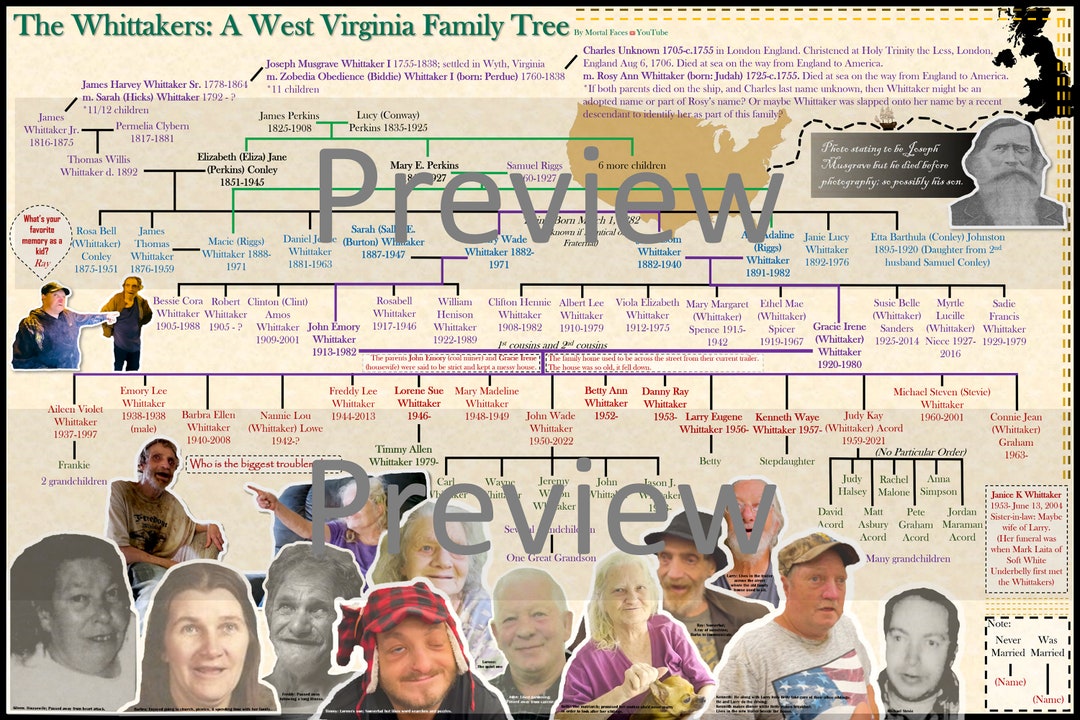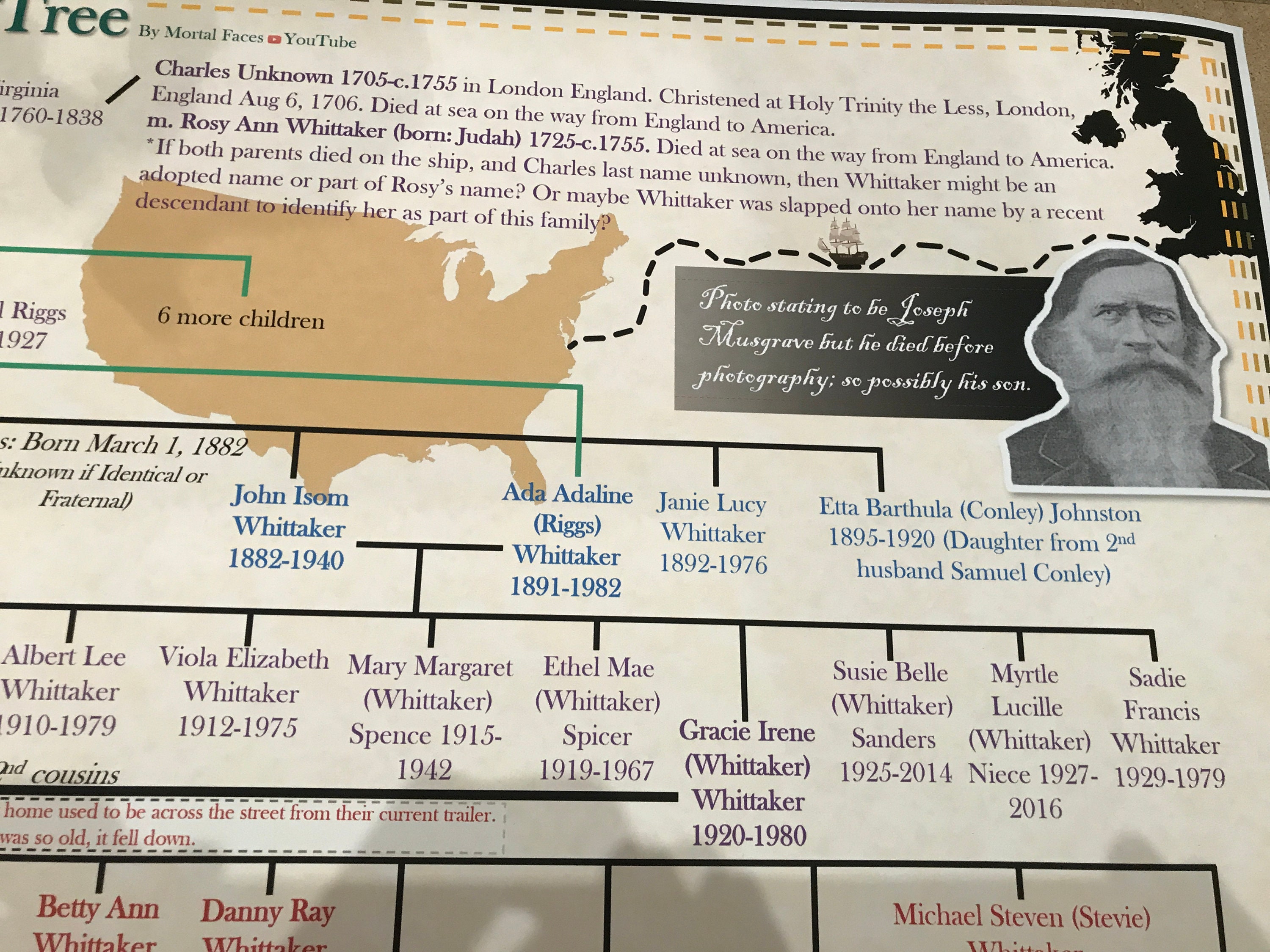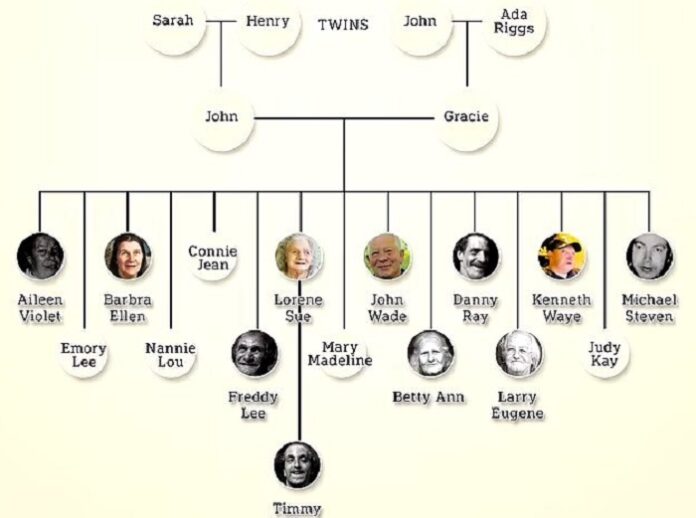The Whittaker Family Tree: Unpacking America's Most Talked-About Lineage
The Whittaker family, hailing from the secluded community of Odd, West Virginia, has garnered significant attention for a family history that is both complex and deeply challenging. Often referred to as "America's most inbred family," their story is a stark illustration of the profound impact that generations of intermarriage can have on health, development, and societal perception. Understanding the intricacies of the Whittaker family tree is essential to grasp the full scope of their unique circumstances, moving beyond sensational headlines to a more nuanced appreciation of their reality.
This article delves into the fascinating and often heartbreaking narrative behind the Whittaker family, tracing their lineage and exploring the factors that led to their current notoriety. From their earliest known roots to the modern-day efforts to document their genealogy and improve their living conditions, we will navigate the branches of the Whittaker family tree, shedding light on a story that continues to captivate and provoke discussion.
Table of Contents
- Tmz Charles Latibeaudiere
- Labia Tattooing
- Where Is Kristina Khorram
- Uncut Wab Series
- Jason Scott Lee Bruce Lee Son
- The Whittaker Family Tree: A Notorious Legacy
- Tracing the Broader Whittaker Family Tree: Ancient Roots and Global Branches
- The Odd, West Virginia Connection: A Family's Secluded Existence
- Origins of a Complex Lineage: The Whittaker Family Tree's West Virginia Genesis
- Unpacking the Genetic Realities: Inbreeding and Its Impact on the Whittaker Family
- The Role of Mark Laita: Bringing the Whittaker Story to Light
- Genealogical Efforts: Documenting the Whittaker Family Tree
- Comparing Lineages: The Whittaker Family vs. Other Complex Trees
- Beyond the Headlines: The Whittaker Family's Ongoing Journey
- Conclusion: The Enduring Narrative of the Whittaker Family Tree
The Whittaker Family Tree: A Notorious Legacy
The Whittaker family from West Virginia has become synonymous with discussions around genetic isolation and its consequences. Their story gained widespread public attention through the work of photographer and filmmaker Mark Laita, who first visited them in 2004 and then reunited with them in 2020. His documentation brought to light the challenging living conditions, unique communication patterns, and visible health defects that have come to define the family in the public eye. The phrase "America's most inbred family" is often used to describe them, a label that, while sensational, points to the deep-seated genetic realities within their lineage. The complexity of the Whittaker family tree is not merely a matter of curiosity; it's a profound case study in human genetics, social isolation, and the resilience of a family living on the fringes of modern society.
Tracing the Broader Whittaker Family Tree: Ancient Roots and Global Branches
While the focus often falls on the West Virginia branch, the surname Whittaker itself has a long and expansive history, with roots stretching back centuries across different continents. Genealogical records indicate a rich tapestry of Whittaker lineages, far removed from the isolated community in Odd. Exploring the broader Whittaker family tree reveals a global spread, with records indicating origins and migrations that predate the specific West Virginia branch by centuries. This wider context helps to illustrate that the family's notoriety stems from a specific, localized set of circumstances, rather than being characteristic of the entire Whittaker surname.
The Early Branches: From England to America
The Whittaker surname has deep historical roots, particularly in England. Records from the 1700s and even earlier suggest a long-standing presence. For instance, some genealogical accounts trace the name back to significant historical events, with one record mentioning a Johias Whitacre born in 1824 who reportedly died alongside Harold II (Harold Godwinson) on the battlefield of Hastings. While this specific detail might pertain to a distinct historical lineage, it underscores the ancient origins of the surname. Over time, branches of the family split, with some remaining in regions like Yorkshire, while others embarked on journeys across the Atlantic, contributing to the establishment of the Whittaker family tree in America. The movement of families from England to Virginia and then to regions like Southeast Missouri further illustrates this extensive migratory pattern.
- Ramadan In Iran
- Cast Of The Jeffersons
- Guerdy Abraira Net Worth
- Current President Of Iran Ebrahim Raisi
- Iran Gdp Growth 2024
The Mobberley Connection and Beyond
Beyond the broader English origins, specific geographical locations are also linked to historical Whittaker families. The data mentions a family in Mobberley, at Vale Wood, among other places. These localized historical records, such as those detailing William Whittaker born on April 14, 1863, at Cambridge Street, Radford, Nottm, who married Ada Young in Hyson Green, Nottm, on July 2, 1887, provide granular insights into individual lives within the larger Whittaker family tree. These details, often found in church records or census data, are crucial for genealogists piecing together the complex puzzle of family histories. They highlight the diverse paths and lives lived by those bearing the Whittaker name, long before the West Virginia branch became known.
The Odd, West Virginia Connection: A Family's Secluded Existence
The remote settlement of Odd, West Virginia, provided the backdrop for the Whittaker family's unique and isolated existence. For generations, this family lived largely outside the public eye, their lives marked by a profound level of secrecy and self-sufficiency. It wasn't until 2020 that Odd's anonymity was ruptured when photographer and filmmaker Mark Laita, following up on reports of an unusual family, found his way to the Whittakers. Their secluded lifestyle, combined with the visible effects of their lineage, quickly propelled them into the national spotlight. This sudden exposure brought both scrutiny and, eventually, a degree of assistance, highlighting the double-edged sword of public attention for a family accustomed to deep privacy. Their location played a significant role in their isolation, allowing the specific dynamics of their Whittaker family tree to develop largely undisturbed for generations.
Origins of a Complex Lineage: The Whittaker Family Tree's West Virginia Genesis
The specific Whittaker family from Odd, West Virginia, whose story has become so widely known, traces its immediate lineage back to the year 1819, spanning six generations. The "Data Kalimat" indicates that their family tree began with identical twin brothers and their children, a critical detail that lays the foundation for understanding the subsequent patterns of inbreeding. This foundational structure, combined with geographic isolation, created an environment where intermarriages within the family became common practice. Over decades, this led to a progressively more complex and interconnected family tree, where familial lines blurred, and genetic commonalities amplified. The initial branching from these twin brothers set a trajectory that would profoundly affect the health and lives of their descendants, creating the unique circumstances observed in the modern Whittaker family.
Unpacking the Genetic Realities: Inbreeding and Its Impact on the Whittaker Family
The most striking and often discussed aspect of the Whittaker family tree is the profound impact of inbreeding and the resulting genetic mutations. The family's complex intermarriages have led to a range of health defects and developmental challenges that are visible and widely reported. These include speech impediments, cognitive impairments, and physical abnormalities. The scientific understanding of inbreeding suggests that it increases the likelihood of recessive genes expressing themselves, leading to a higher incidence of genetic disorders. In the Whittaker family's case, the continuous intermarriage over generations has concentrated these recessive traits, manifesting in the health issues observed today. While the specific genetic conditions are not detailed in the provided data, the general impact on their health and lives is clear, underscoring the critical importance of genetic diversity for long-term health and well-being within a population. The ongoing effects of their unique Whittaker family tree are a stark reminder of these genetic principles.
The Role of Mark Laita: Bringing the Whittaker Story to Light
The world's awareness of the Whittaker family largely stems from the dedicated efforts of photographer and filmmaker Mark Laita. His initial visit in 2004 marked the beginning of his engagement with the family, though it was his return in 2020 that truly brought their story to a global audience. Laita's documentation went beyond mere sensationalism; he aimed to tell their story, detailing their lifestyle, their challenging living conditions, and their complex family history. Crucially, his involvement also led to tangible improvements in their lives. By sharing their story, Laita helped raise awareness and generate support, which in turn contributed to improving their living conditions. His work provided a crucial bridge between the Whittaker family's isolated existence and the broader world, fostering a degree of understanding and compassion that might not have otherwise materialized. The exposure he provided was instrumental in revealing the intricate nature of the Whittaker family tree to a wider audience.
Genealogical Efforts: Documenting the Whittaker Family Tree
Despite the notoriety surrounding the West Virginia branch, the broader Whittaker family tree is a subject of extensive genealogical research. Platforms dedicated to family history play a crucial role in piecing together these vast and intricate lineages. The sheer volume of data available on various genealogical sites highlights the widespread nature of the Whittaker surname and the ongoing efforts by enthusiasts and professionals alike to document its many branches. These resources offer a window into the diverse histories of individuals bearing the Whittaker name, from historical figures to contemporary individuals, showcasing the depth and breadth of their ancestry. Understanding these broader efforts helps to contextualize the specific West Virginia branch within a much larger and more varied family history.
Wikitree: A Collaborative Approach to the Whittaker Lineage
Wikitree stands out as a prominent platform for collaborative genealogy, and it actively hosts profiles for Whittaker ancestors. It's a community where 135 "Whitaker genealogists and amateur family historians" dedicate themselves to growing an accurate, collaborative family tree. The platform's commitment to being "100% free and accessible to everyone forever" underscores its mission to democratize genealogical research. Users can search for specific Whittaker ancestors, share their own findings, and even compare DNA results to further refine and expand the global family tree. This collaborative environment ensures that the Whittaker family tree, in its many forms, is meticulously documented and continuously updated, offering a valuable resource for anyone tracing their lineage or studying family history.
Geni.com: Exploring the Global Whittaker Family Tree
Another significant resource for exploring the Whittaker family tree is Geni.com, which boasts an impressive 8,324 profiles for the Whittaker family. As one of the world's largest family tree platforms, Geni.com provides a comprehensive database for exploring Whittaker genealogy and family history on a global scale. The sheer number of profiles indicates the extensive reach and historical depth of the surname across various regions and time periods. Users can delve into these profiles to uncover connections, trace migratory paths, and learn about individual family members, such as William Whittaker born in 1863, and his marriage to Ada Young. These platforms are indispensable tools for genealogists, allowing them to piece together fragmented histories and build a more complete picture of the Whittaker family's vast and diverse heritage.
Comparing Lineages: The Whittaker Family vs. Other Complex Trees
The unique genetic challenges faced by the West Virginia Whittakers prompt interesting comparisons with other families known for complex or isolated lineages. The data mentions research into the "Colt family," noting that their family tree is "way worse and has way more overlaps" in terms of intermarriage. Yet, despite this, the Colt family reportedly has "no where near the amount of genetic issues that the Whittaker family has." This observation raises a crucial point: genetic outcomes are not solely determined by the degree of inbreeding. Other factors, possibly related to the specific genetic predispositions within the founding members of a lineage or environmental influences ("nature as well"), can play a significant role in how genetic issues manifest. This comparison highlights the multifaceted nature of genetic inheritance and the complex interplay of various factors that shape a family's health profile, making the Whittaker family tree a particularly compelling case study in this broader context.
Beyond the Headlines: The Whittaker Family's Ongoing Journey
The story of the Whittaker family is not static; it's an ongoing narrative of resilience, adaptation, and the enduring impact of their unique family history. While their initial discovery brought intense public scrutiny, it also catalyzed efforts to improve their living conditions and provide support. Mark Laita's continued documentation, including his reunions with the family, helps to keep their story in the public consciousness, reminding us of their humanity beyond the sensational headlines. The family's secrecy, once a barrier, has slowly given way to a cautious openness, allowing glimpses into their daily lives and the challenges they navigate. As their story continues to unfold, the Whittaker family tree remains a powerful symbol of the complexities inherent in human lineage, genetic legacy, and the societal responsibility to understand and support those living in challenging circumstances.
Conclusion: The Enduring Narrative of the Whittaker Family Tree
The Whittaker family tree, particularly the branch from Odd, West Virginia, represents a compelling and often poignant narrative of genetic isolation, historical circumstances, and human resilience. From its earliest traceable roots in the 19th century with identical twin brothers, through six generations of complex intermarriages, the family's lineage has profoundly shaped their health and lives. While their story is frequently sensationalized, a deeper look reveals a family navigating extraordinary challenges, brought to light by the dedicated efforts of individuals like Mark Laita, who not only documented their lives but also helped improve them.
Beyond the specific West Virginia branch, the broader Whittaker family tree spans centuries and continents, demonstrating the vast and diverse history of the surname. Genealogical platforms like Wikitree and Geni.com continue to meticulously document these lineages, offering invaluable resources for understanding the intricate tapestry of human ancestry. The Whittaker family's story serves as a powerful reminder of the delicate balance of genetics, environment, and social factors that shape human lives. It encourages us to look beyond initial perceptions and consider the complex forces at play. We invite you to share your thoughts on this profound story in the comments below, or explore other articles on our site that delve into fascinating family histories and genealogical insights.
- Is Lena Miculek Still Married
- Linda Florentino
- The Rookie Where To Watch
- Penchod Meaning In English
- Population Of Sunni In Iran

The Whittaker's Inbred Family Tree 30in X 20in Poster Digital Download

The Whittaker's Inbred Family Tree 30in X 20in Poster - Digital

Meet the Whittakers: America's Most Inbred Family